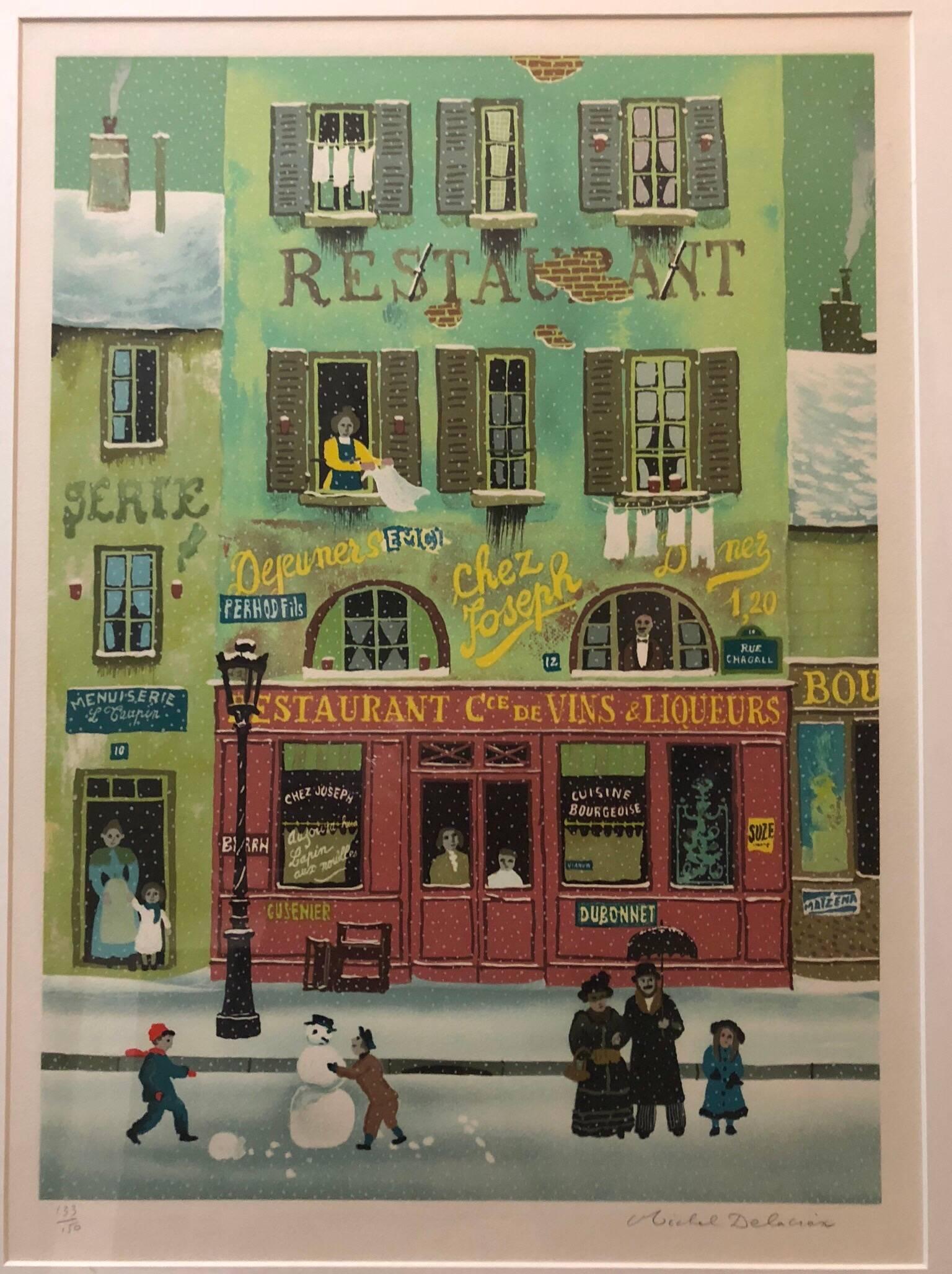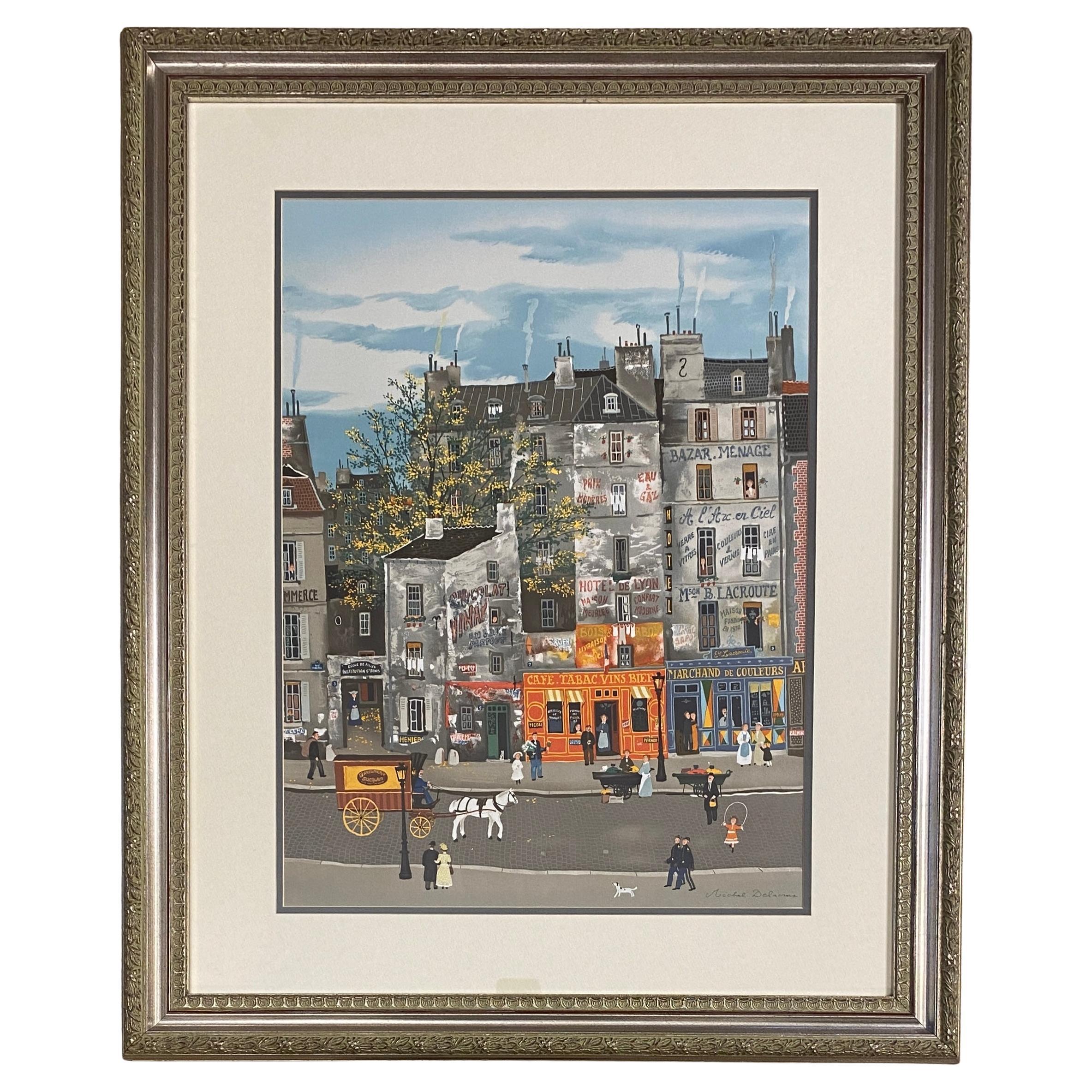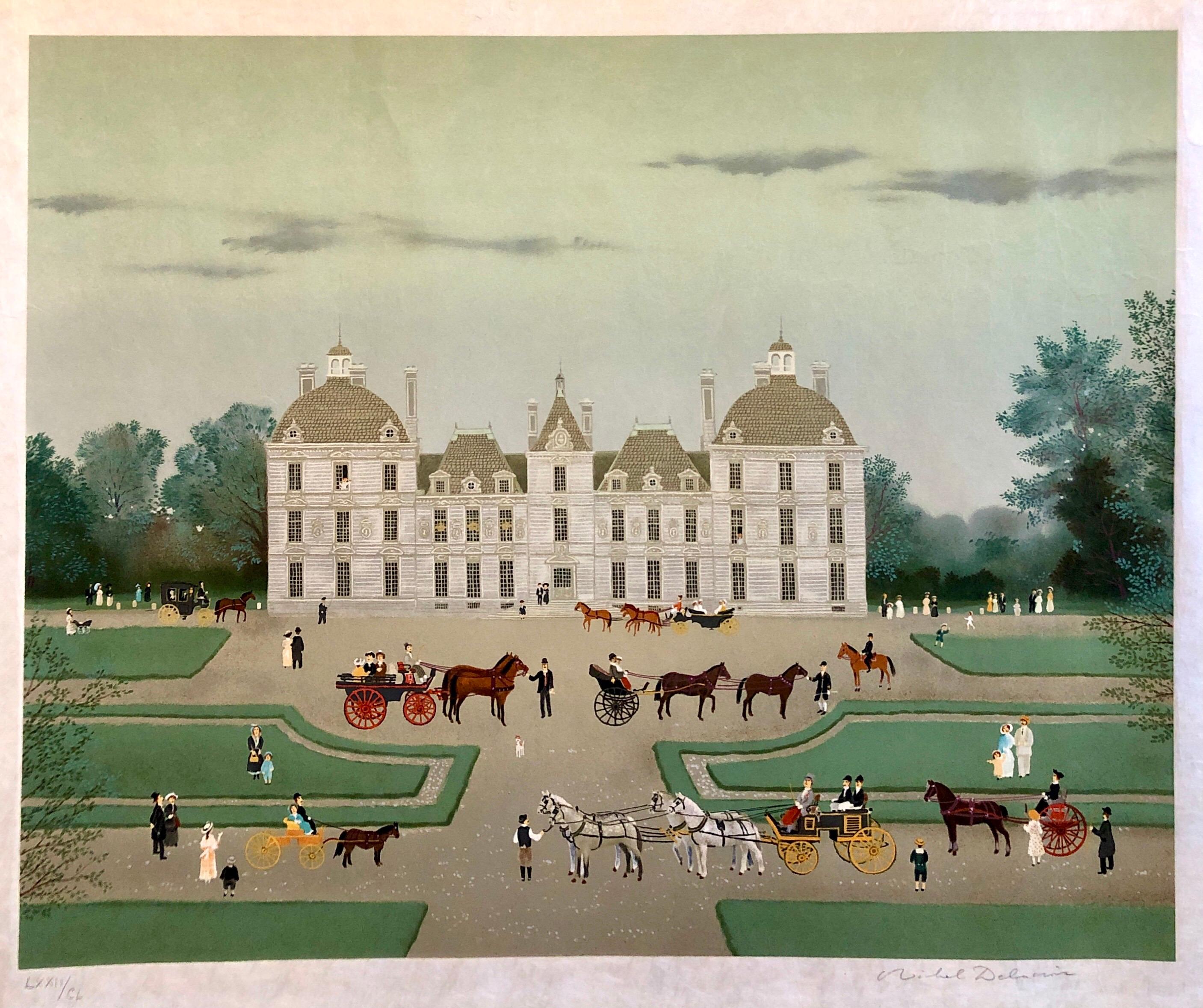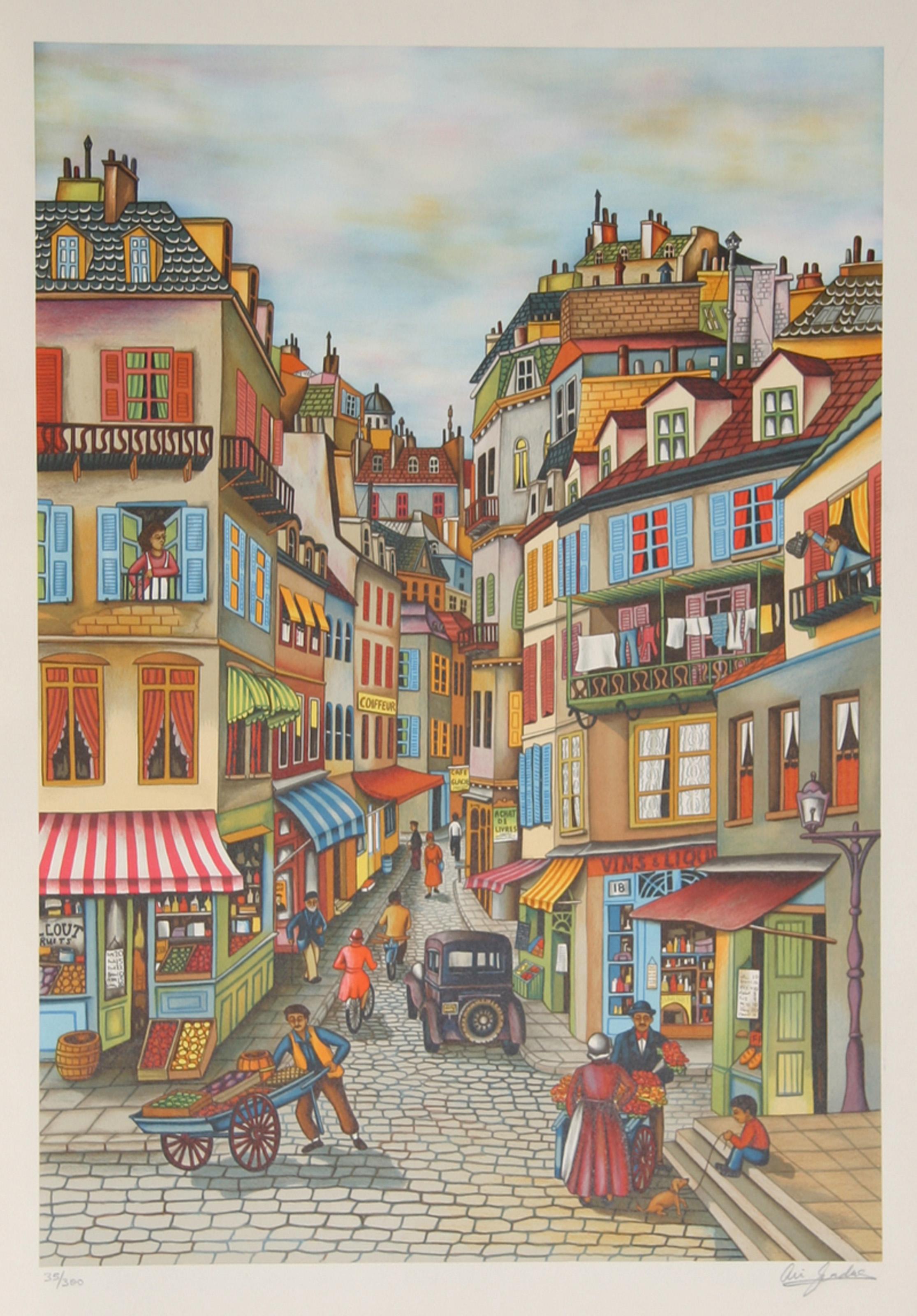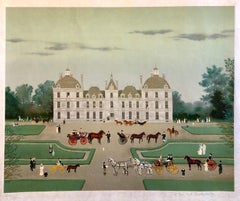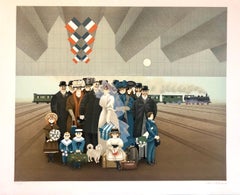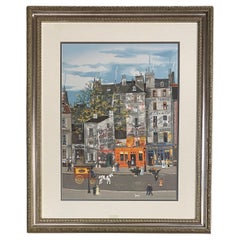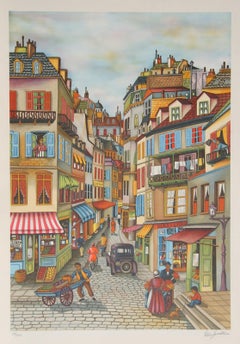Items Similar to Hand signed Folk Art Naive lithograph on Arches paper Paris Evening Cafe Scene
Want more images or videos?
Request additional images or videos from the seller
1 of 12
Michel DelacroixHand signed Folk Art Naive lithograph on Arches paper Paris Evening Cafe Scene
$1,750
£1,307.17
€1,515.45
CA$2,429.83
A$2,723.53
CHF 1,418.06
MX$33,255.44
NOK 18,004.22
SEK 17,066.39
DKK 11,306.90
Shipping
Retrieving quote...The 1stDibs Promise:
Authenticity Guarantee,
Money-Back Guarantee,
24-Hour Cancellation
About the Item
size includes frame: 32.5" H x 26.5" W;
Lithograph in colors depicting an enchanted evening in Paris with a bright cafe and a church or public building on a charming Paris square. Signed in bottom right margin "Michel Delacroix," in pencil and numbered "59/150" at left. matted and contained under glass in a wood frame.
classic paris street scene with bicycle, cafes and shops. Michel Delacroix master of the Naïf (Folk Art or Naive) the most popular and successful artists in the world today. A self-styled "painter of dreams and of the poetic past," Delacroix has devoted five decades to painting a city he calls "the Paris of then," the magical place where he was born, where he spent his boyhood, and where he continues to live to this day.
But the Paris Delacroix paints is not the urban metropolis of the present. It is the dream-like place the city became in the 1940's, during the Occupation, when "we suddenly jumped fifty years into the past. No more cars in the streets, very few lights. Paris suddenly became very quiet, very dark, and, though people were afraid, there was a brotherhood and spirit that was very delightful." For Delacroix, who was then a child of seven and spared by his age from understanding "the cruelties and absurdities" of war, it was "the one great adventure of my life."
And it is to this special Paris - the Paris of by-gone years and innocent splendors - that Delacroix has returned to over and over again in his gentle works. Theses works, renowned for their graceful balance of "the earthy and the urban, the cosmic and the ordinary," have captivated private collectors, museums and ordinary people alike throughout the world, earning the artist both universal acclaim and numerous awards.
In the U.S. alone, Delacroix's work has been featured in over 275 one person shows, from New York City, Boston, and Washington D.C., to Los Angeles, Carmel, Denver, Seattle, and San Francisco. Abroad, his work has been exhibited in France, Switzerland, Germany, Luxembourg, England, Japan, and forms part of the permanent collections of the Musee International d'Art Naïf and the Foundation Max Fourny in Paris, and of private collections around the globe.
Dimensions:
- Creator:Michel Delacroix (1933, French)
- Dimensions:Height: 32.5 in (82.55 cm)Width: 26.5 in (67.31 cm)
- Medium:
- Movement & Style:
- Period:
- Condition:minor wear to frame.
- Gallery Location:Surfside, FL
- Reference Number:1stDibs: LU38212695682
Michel Delacroix
Internationally renowned French painter Michel Delacroix is an acclaimed master of the naïf tradition and one of the most popular collected artists in the world today. A self-styled painter of dreams and the poetic past, Delacroix continued to paint and experiment with a variety of techniques and styles before eventually developing his signature style, depicting scenes of Paris as a happy, timeless and magical place. He has been exhibiting one-man shows all over the world, and his works are collected by major museums and private collectors worldwide.
About the Seller
4.9
Platinum Seller
Premium sellers with a 4.7+ rating and 24-hour response times
Established in 1995
1stDibs seller since 2014
1,777 sales on 1stDibs
Typical response time: <1 hour
- ShippingRetrieving quote...Shipping from: Surfside, FL
- Return Policy
Authenticity Guarantee
In the unlikely event there’s an issue with an item’s authenticity, contact us within 1 year for a full refund. DetailsMoney-Back Guarantee
If your item is not as described, is damaged in transit, or does not arrive, contact us within 7 days for a full refund. Details24-Hour Cancellation
You have a 24-hour grace period in which to reconsider your purchase, with no questions asked.Vetted Professional Sellers
Our world-class sellers must adhere to strict standards for service and quality, maintaining the integrity of our listings.Price-Match Guarantee
If you find that a seller listed the same item for a lower price elsewhere, we’ll match it.Trusted Global Delivery
Our best-in-class carrier network provides specialized shipping options worldwide, including custom delivery.More From This Seller
View AllHand signed Folk Art Naive lithograph on Arches Paper Paris Snowman Scene
By Michel Delacroix
Located in Surfside, FL
Lithograph in colors depicting an enchanted evening in Paris with a snowman and children playing outside the restaurant Chez Joseph on a winter day. Signed in bottom right margin "M...
Category
20th Century Folk Art Figurative Prints
Materials
Lithograph
Hand signed Folk Art Naive lithograph on Japon Paper Paris French Country Scene
By Michel Delacroix
Located in Surfside, FL
Château de Cheverny in the Loire Valley of France
Lithograph in colors depicting an enchanted evening at Cheverny with a horse drawn wagon and carriages on a winter day, Signed in...
Category
20th Century Folk Art Figurative Prints
Materials
Lithograph
Large Modernist Paris Street Scene Wine Shop Montmartre Cafe Ladies Lithograph
By Charles Levier
Located in Surfside, FL
Framed 32 x 26 image 22 x 16
Charles Levier (1920-2004)
He was born in 1920 of a French father and American mother in Corsica. He held a fascination with color and form that led him...
Category
Mid-20th Century Modern Figurative Prints
Materials
Lithograph
Naive Lithograph Paris Train Station Wedding Party, Honeymoon Scene Folk Art
Located in Surfside, FL
Hand signed, limited edition on BFK Rives French art paper. I believe the title is Honeymoon.
Jan Balet (20 July 1913 in Bremen – 31 January 2009 in Estavayer le Lac, Switzerland), w...
Category
20th Century Folk Art Figurative Prints
Materials
Lithograph
Czech Street Scene, Kino, Couples Shopping Weimar Era 1929 Lithograph
By Vojtech Tittelbach
Located in Surfside, FL
Man in bowler hat, ladies in hats out shopping.
Vojtěch Tittelbach ( 1900, Mutějovice - 1971, Prague) was a Czech painter and graphic artist, gradua...
Category
1920s Expressionist Figurative Prints
Materials
Lithograph
Colorful Russian French Judaica Jewish Shtetl Wedding Lithograph Mourlot Paris
By Mane Katz
Located in Surfside, FL
Mane-Katz (1894-1962) Original Lithograph published by Andre Sauret, Monte Carlo, 1966, printed in France, by Mourlot. The ouvrage sheet is not included. this is from a limited editi...
Category
1960s Modern Figurative Prints
Materials
Lithograph
You May Also Like
France : Traditional Village - Lithograph poster
By Michel Delacroix
Located in Paris, IDF
Michel DELACROIX
France : Traditional Village
Lithograph
Printed signature in the plate
On wove paper 85 x 59 cm (c. 34 x 24 inch)
Lithographic poster for the artist personal exhibi...
Category
1970s Modern Figurative Prints
Materials
Lithograph
Michel Delacroix Lithograph French Cityscape & Figurative Parisian Life Art
By Michel Delacroix
Located in Miami, FL
A wonderfully decorative lithograph by Michel Delacroix, signed in the plate on the bottom right corner. Housed in a beautiful, quality silvered wood frame this color lithograph displays wonderfully.
Michel Delacroix (1933- ) Internationally renowned French painter Michel Delacroix is an acclaimed master of the naïf tradition and one of the most popular collected artists in the world today. A self-styled "painter of dreams and of the poetic past," Delacroix continued to paint and experiment with a variety of techniques and styles before eventually developing his signature style, depicting scenes of Paris as a happy, timeless and magical place. He has been exhibited in one man shows all over the world, and his works are collected by major museums and private collectors world-wide.
This lithograph by Michel Delacroix would enhance any traditional, contemporary or modern setting.
Dimensions: Width 34.25" x Depth 1.50" x Height 34.25"
Michel Delacroix stone signed lithograph from Paris, France
This Michel Delacroix Lithograph...
Category
20th Century French Mid-Century Modern Prints
Materials
Wood, Paper
Parisian Morning, Folk Art Lithograph by Ari Gradus
By Ari Gradus
Located in Long Island City, NY
Ari Gradus, Israeli (1943 - ) - Parisian Morning, Year: 1980, Medium: Lithograph, Signed and Numbered in Pencil, Edition: AP, Size: 30 in. x 22 in. (76...
Category
1980s Folk Art Landscape Prints
Materials
Lithograph
"Magic Circus" framed lithograph by Michel Delacroix hand signed and numbered
By Michel Delacroix
Located in Boca Raton, FL
"Magic Circus" lithograph by Michel Delacroix. Hand-signed MIchel Delacroix. Hand-numbered XX/C. Depicts a circus, complete with elephant and horses, traveling through a French city...
Category
20th Century Other Art Style Animal Prints
Materials
Lithograph
Michel Delacroix -- Rendez Vous de Macons
By Michel Delacroix
Located in BRUCE, ACT
Michel Delacroix
Rendez Vous de Macons, 1984
Original lithograph
Hand signed in pencil lower right
Edition E.A. lower left
Published by Lublin Graphics
A lovely street scene view ...
Category
1980s Prints and Multiples
Materials
Lithograph
Vintage Michel Delacroix Le Chevet de Notre Dame Paris France Lithograph 33"
Located in Dayton, OH
Late 20th century lithograph poster print titled "Le Chevet de Notre Dame la Nuit" (Our Lady's Bedside at Night) by Michel Delacroix. Depicts a nighttime ...
Category
Late 20th Century Prints
Materials
Paper
$240 Sale Price
20% Off
More Ways To Browse
Folk Art Church
Naive Art Germany
Michel Delacroix Paris
Michel Delacroix Signed
Michel Delacroix Lithograph
Michel Delacroix Bicycles
Michelangelo Etching
Nude Vintage Poster
Shepard Fairey Hope
Tom Phillips
Vintage Woodcut
Copper Plate Picasso
Cubist Jazz
Dove Matisse
Egypt Travel Poster
French Vintage Circus Poster
Gagosian Poster
Jeanne Marc Vintage
